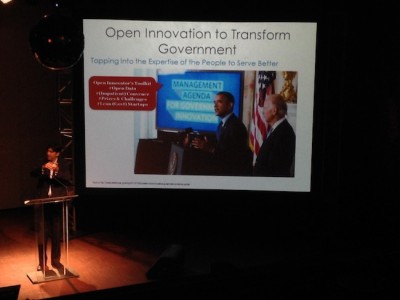In the 1980s, Ronald Reagan famously said “the nine most terrifying words in the English language are ‘I’m from the government, and I’m here to help.’” Yet today’s open gov movements have helped bring new perspective. Aneesh Chopra, the first Chief Technology Officer of the United States federal government, challenged this axiom in a serious way.
Speaking at Phorum, the annual day-long investment conference held by PACT as part of Philly Tech Week this year, Chopra shed light three ways government, borrowing from the private sector, is constantly improving.
First, government is fast when given the right incentives. Technology helps citizens “leapfrog” complicated government processes. Early in his tenure as CTO, Chopra and his counterpart Sam Pitroda, organized the first U.S-India Open Government Dialogue to showcase 21st century technology opportunities in the world’s largest democracy. On “90-days notice,” government officials installed a 4G network in a remote village ahead of President Obama’s November 2010 visit.
The new Internet access allowed villagers to “leapfrog” many levels of “extra-legal” challenges.
Second, citing a Corporate Executive Board report, Chopra underscored two internal barriers researchers found in industry leading companies that were eventually unseated.
The results suggested “premium position captivity,” or hubris, inhibited businesses from accepting innovative ideas. Industry leaders also suffer from “innovation management breakdown.” This happens when a clear system to turn ideas into “commodifiable” products and services is absent. Collectively, these inhibitors are called “growth stalls.”
“Stalls are pervasive,” but “stalls are preventable,” he explained.
Chopra’s third lesson from his tenure was the power of collaboration.
In 2010, a 7.0 earthquake ravaged Haiti killing 250,000 people. However a White House staffer, who called a friend in Kenya, coordinated the development of an SMS texting system to find survivors. After building the SMS system, Crowdflower, a California startup, leveraged its large freelance network to translate texts from Creole to English. This reduced the average response time from text to aid worker arrival to just 10 minutes.
Since leaving the White House in 2012, Chopra, whose father is an alumnus of Villanova University, ran for Lieutenant Governor in Virginia (he lost) and subsequently co-founded Hunch Analytics. Hunch Analytics parses “a mashup of public and private data” in healthcare, education and energy to deliver actionable insights to customers.
Chopra emphasized a parallel between innovating in the public and private sector. “The best thing that we can do inside our organizations,” he concluded, “is to begin punching a hole in that wall of disbelief.”
Join the conversation!
Find news, events, jobs and people who share your interests on Technical.ly's open community Slack

Philly daily roundup: Student-made college cost app; Central High is robotics world champ; Internet subsidy expiration looms

Delaware daily roundup: Early-stage loan help; Jobless rate drops below 4%; $700k grant for industrial park

Philly daily roundup: Earth Day glossary; Gen AI's energy cost; Biotech incubator in Horsham

